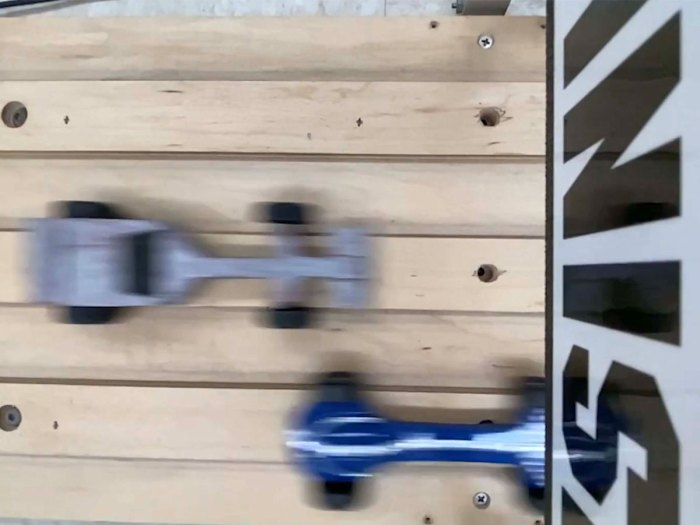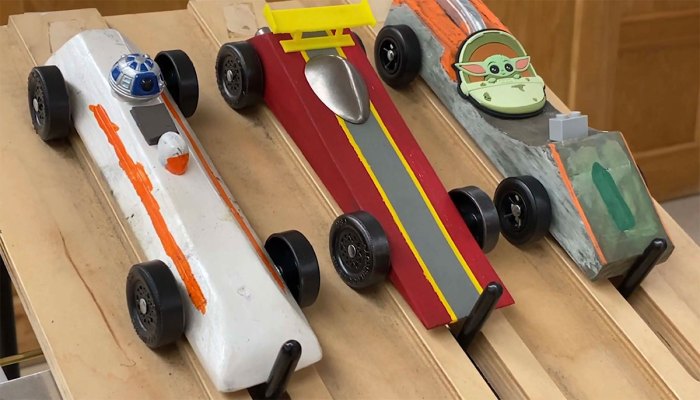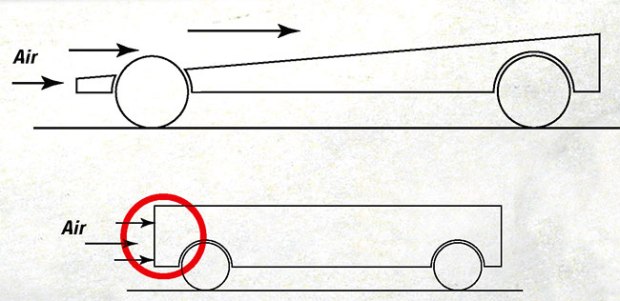How to Make a Fast Pinewood Derby Car

Packs nationwide are gearing up for their annual Pinewood Derby race, and the one thing everyone wants to know: How do I make a fast Pinewood Derby car?
There are a variety of ways to make your Pinewood Derby car go faster. Explore the following tips to optimize your car’s performance and gain a competitive edge in an upcoming race.
BASIC BUILDING GUIDELINES TO GET YOU STARTED
The possibilities are endless when it comes to creating a fast Pinewood Derby car. Before you begin, consider the following general guidelines:
Avoid Pointed Noses: A pointed nose will make it difficult for your car to rest on the pin at the starting gate. It may also cause your Pinewood Derby car to get bumped around when the pin drops, and it can create problems for electronic timing systems at the finish line.
Weight Distribution: Leave ample wood in the rear of the Pinewood Derby car so you can place additional weight there. Concentrate the majority of the weight in the rear for optimal performance.
Maximum Weight: Aim for the maximum allowable weight allowed by your pack’s rules, typically limited to 5 ounces in most races. If your car falls short of this weight, strategically add coins or other weights to meet the requirement.
Clarity in Orientation: Clearly distinguish the front and back of your Pinewood Derby car. In many races, the race officials — not you — will actually place each car on the track. Sometimes the officials put cars on the track backward because they can’t tell which end is which.
Aerodynamic Design: Select a design that facilitates smooth airflow over and around the car body. Pinewood Derby cars with aerodynamic profiles go faster.
Need design ideas? See photo galleries of hundreds of Pinewood Derby cars.

10 STEPS FOR DESIGNING AND BUILDING A FAST PINEWOOD DERBY CAR
You don’t have to strive for the fastest Pinewood Derby car to have fun competing in your Pinewood Derby. But if you and a helpful adult are willing to put in the extra time and effort, these speed tips are for you.
1. Bake the Block: Start your Pinewood Derby car project by baking the wood block at 250 degrees for two hours. This removes moisture and lightens the block, allowing you to place more weight at the rear of the car where you actually want it.

2. Crafting the Design: Outline your Pinewood Derby car on paper, cut it out, and affix it to the wood block.
Remember, a rectangular car is not an aerodynamic design. The most basic aerodynamic design is a simple wedge. If you don’t have time to design a complex car, a wedge will work just fine.
Download a Pinewood Derby car template PDF to help you create your design.
3. Rough Cut the Design: Use a coping saw or enlist the help of a responsible adult with a power tool to cut out the rough shape of your Pinewood Derby car.
4. Shape Your Car: Smooth edges and shape your car using sandpaper. An adult can assist with a rotary tool or other shaping tools.
5. Sand and Paint Creatively: Reduce friction by smoothing the car’s surface and paint an awesome design to make it look great.
How to paint your Pinewood Derby car to give it a shiny finish.
6. Axles and Wheels Alignment: Make sure they are aligned perfectly straight. You can test the alignment of your axles by pushing your car across a smooth floor or table. It should roll smoothly in a straight line.
- Consider a Three-Wheeler: Raise one wheel about 1/16 inch higher so it never actually touches the track. Less friction = more speed. Rules vary from pack to pack, so make sure to check your pack’s Pinewood Derby rules to make sure three wheelers are allowed in your race.
- Extend the Wheelbase: Maximize the distance between front and rear wheels. Again, make sure this is allowed in your race.
Inspect axles closely to make sure they are smooth without ridges or burrs. You can use sandpaper to remove any imperfections.
Learn about polishing Pinewood Derby axles and wheels to reduce friction.
7. Secure Axles with Glue: Glue the axles firmly in their holes to ensure that they stay perfectly placed, but make sure you don’t get glue on your wheels.
8. Strategic Weight Addition: Remember to make your Pinewood Derby car as heavy as the rules allow. In general, it’s best to place weight to the rear of your car because a heavier rear increases speed.
Learn scientific Pinewood Derby speed tips from a former NASA engineer.
9. Use Graphite: Add graphite or another dry lubricant to reduce friction. The less friction between the body and wheel, the better.
10. Have fun! And finally, remember the most important rule of a Pinewood Derby is that it’s supposed to be fun. While you should always strive to do your best, don’t get caught up in winning or having the fastest car. Just enjoy the ride.
Adapted from the book “Pinewood Derby Speed Secrets,” DK Publishing, $12.95 softcover.
what should i use to enhance my wheels?
In the BSA kit the axles(nails) have ridges in them, is it okay to sand them off?
cool tricks they realy work
In our Pack we do not allow three wheels on the track – it is a 4 wheel event. We also allow the polishing of the nails (axles) and you should definitely remove the burrs on the heads – this is what slows the car down right out of the box.
you want your car to work correctly, than yes you should
if you want a fast car, you should
does trail to eagle cover first class
yes
There are all kinds of web sites that tell you how to file, sand & polish the axels but we were told by Pack Leader and race officials absolutely not. We were to remove parts from box and to use as is to ensure even and fair races.
yes it is ok
NO if you sand your axels it can go in in even and slow your car down you should probably just get a new set of Axel’s they sell them as far as I know of at micheals and BSA stores
Yes, sand/file off the ridges. Use a triangle file to round or bevel the hub as to not rub on the wheel. The axle should be wet sanded starting with at least 300 and progress up to 2000 wet sand. The shinier the better.
Be sure to check your District’s rules before assuming these modifications are permitted. In our district, we must use only the materials in the derby kit (i.e., no precut cars from the hobby shop, non-BSA wheels and axels, liquid lubricant, etc.). Further, changing the wheelbase in many districts is a big no-no.
Terrific book!! I like the fact that the author keeps telling you to check your local pack rules. My son has about worn this book out!!! Great book! Thanks for helping many boys dreams come true.
Another speed tip: Use the power/cordless drill to polish off those burrs in the axle (nails) to gain more speed. Insert the nail tip in the power drill, tear off a 1/4″-1/2″ strip of 150 grit sandpaper, wrap it around the nail and polish that burr off first. Then use 320-400 grit after that, then work your way up. I go as far as 1000-1500 wet/dry paper to get is super smooth. Less friction=SPEED 🙂
use the flakes of graphite and spin your weals
I am helping my son build his first derby car. The race is Jan. 28th. I have a question. The wood block comes with the axle slots in it already. Do you just hammer in the axles and they stay in the slots without popping off the bottom? Seems like they would come off the car a lot… Any advice would be great!
Correct, it will not go out the bottom of the slot. Also, don’t use a hammer because you could bend the nail. Line it up well and push it right in with your finger or with another small piece of wood…Press fit
Ok, thanks. We are baking the block today and are going to band saw out the car design. I will make sure we do not hammer the axles in.
it depends the way you want it.But I think maybe if you pound them in, it would keep the wheels on better. But I can’t guarantee the car will go fast.
Good luck!
Sometimes it helps to put a wheelguard over the axles. You could put a dab of glue near the axles just in case. Do NOT get glue on the wheels. I have a friend that put glue on his axles, and overnight the glue seeped onto one of the wheels. !t didn’t spin at all. Be careful and have fun!
You can leave them just hammered in, but Ive been racing a wile and i recamend you super glue the bottom.
glue them!
Boys life is great!!
what is the scientific reason to make it the heaviest so its the fastest
Larger mass means larger momentum. The larger the momentum, the longer it takes the frictional force to reduce the speed to 0.
About half the tips in this article are illegal in our derby and would not past inspection. Glue on the axel, 3 wheels touching, Extending the wheel base are all against the rules, so make sure you know your rules before doing any of these tips.
Good point!!! In our pack it is legal to have three wheels touching and an extended wheel base. However; when in doubt check with your individual pack, district rules.